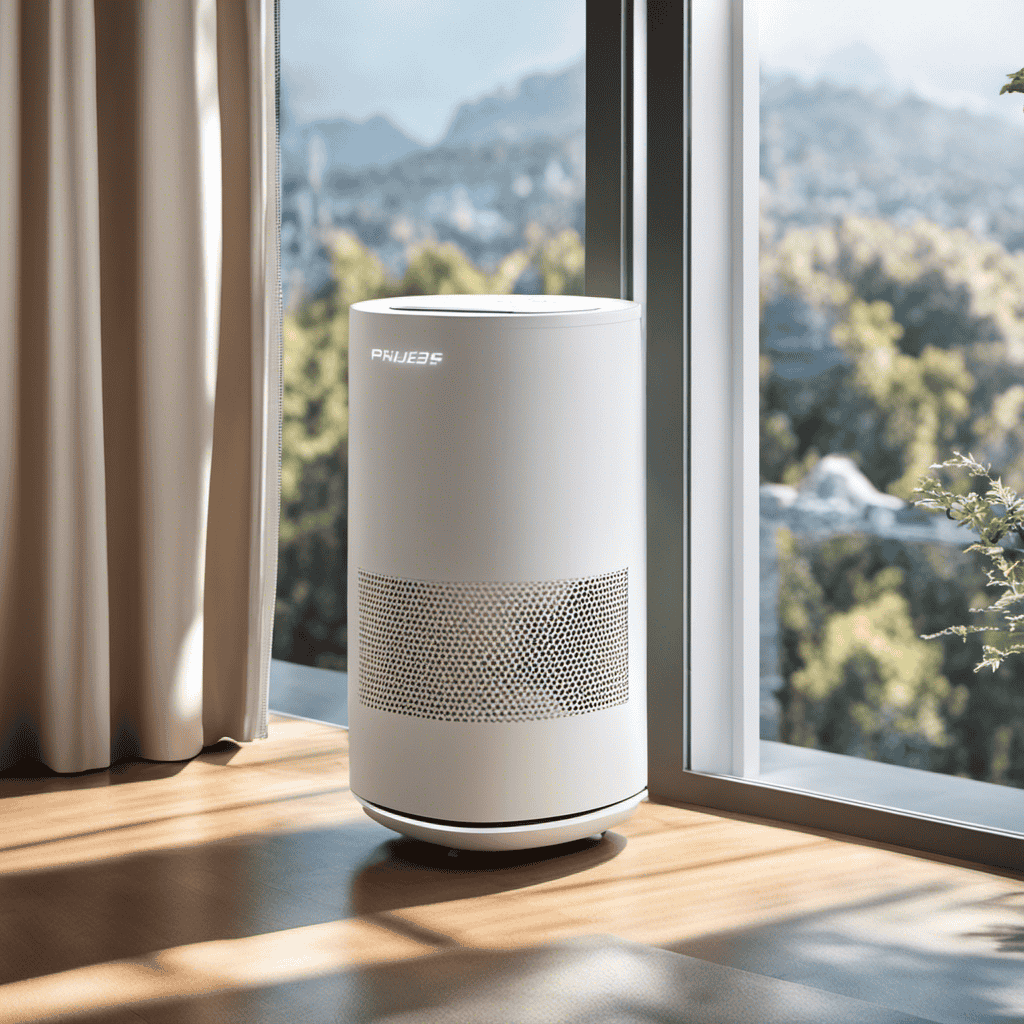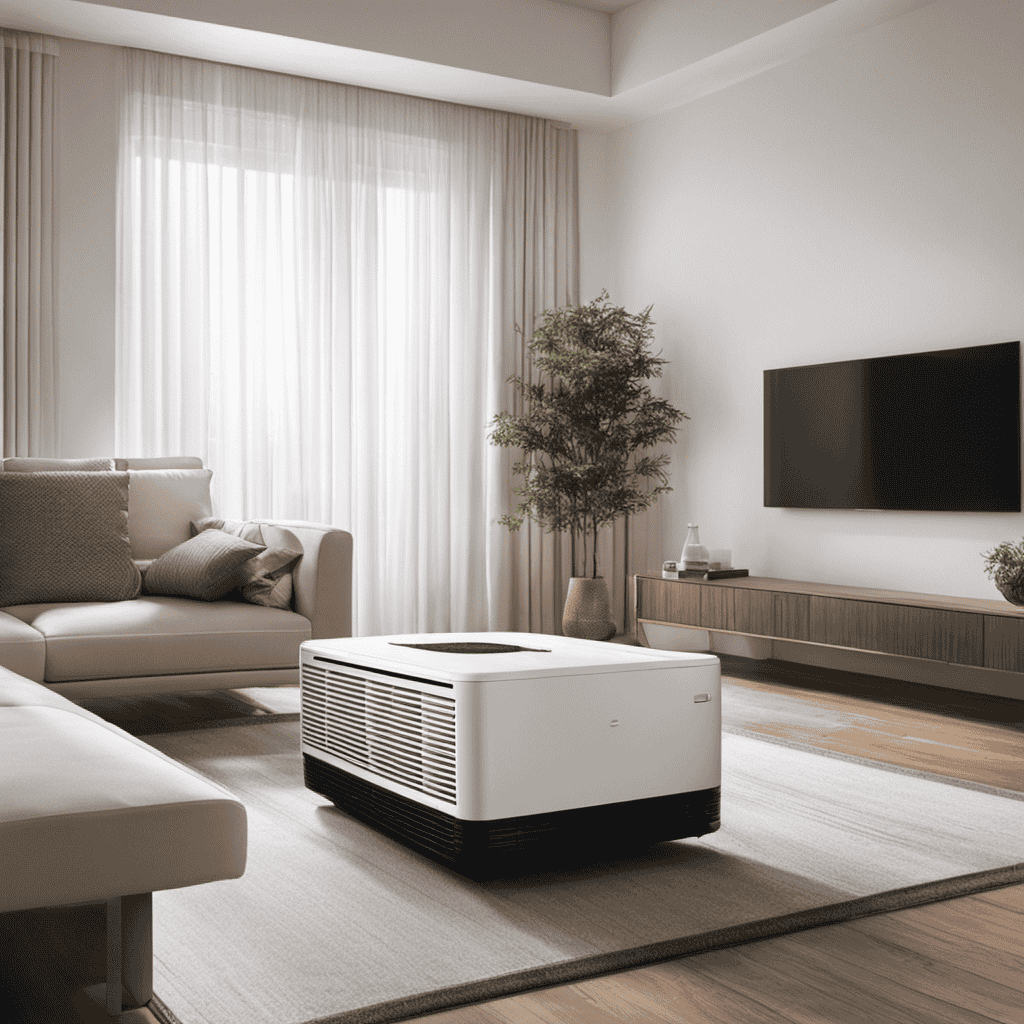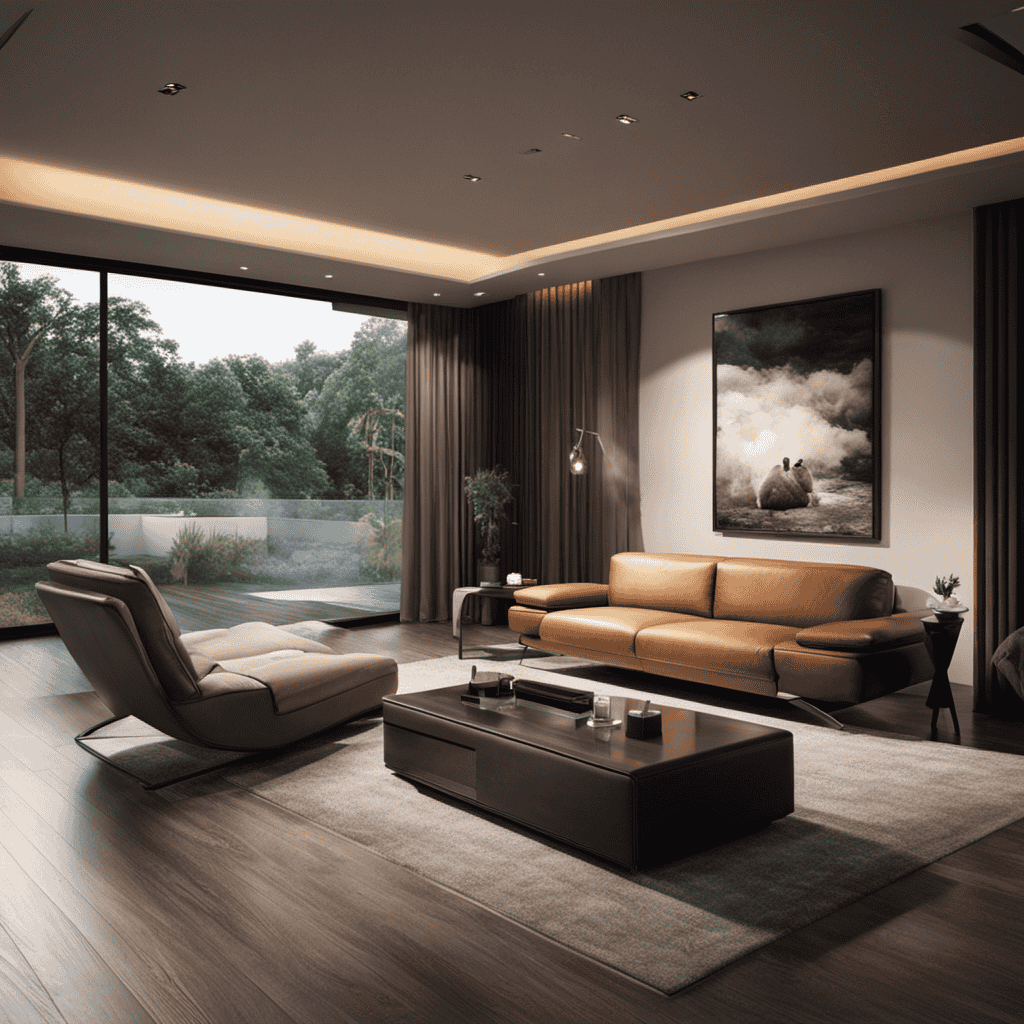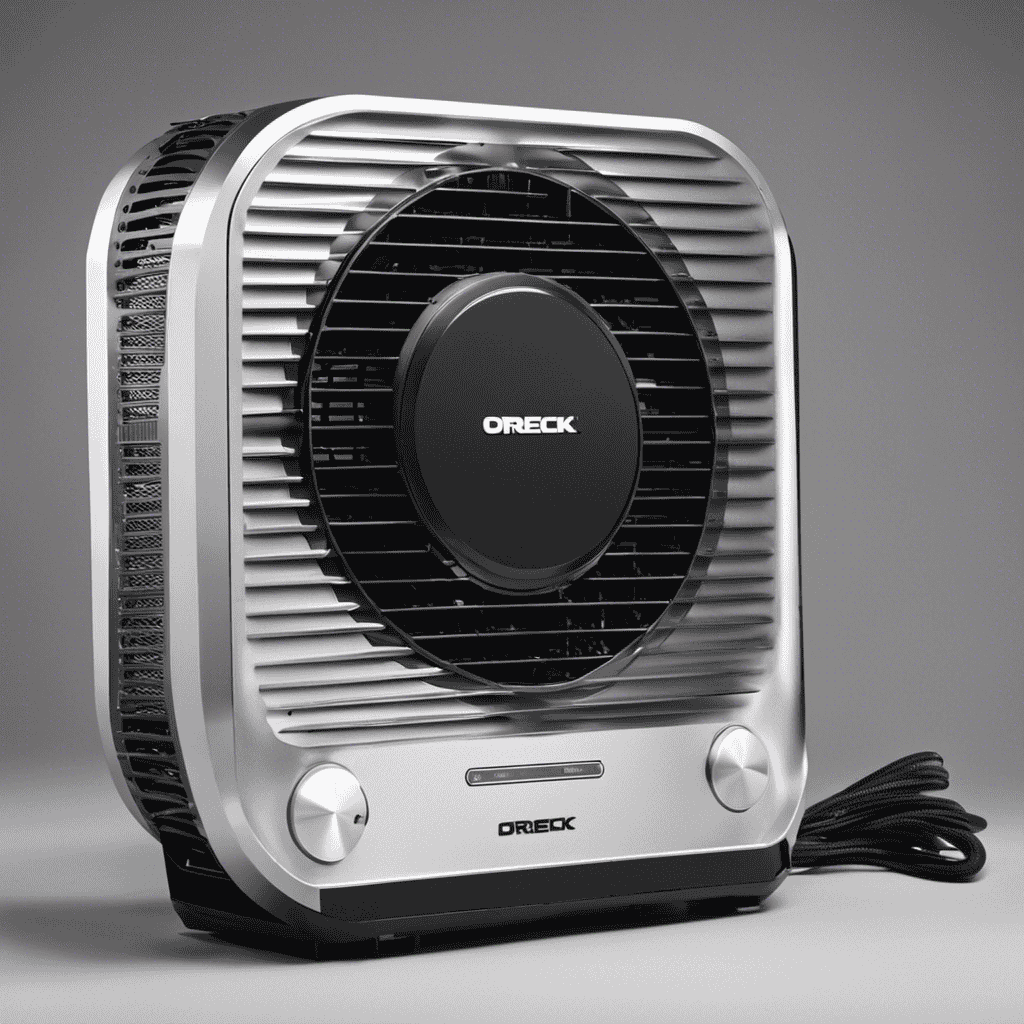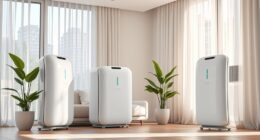Were you aware that the air inside can be up to five times more contaminated than the air outside?
In this article, I will explore the key differences between air purifiers and air humidifiers. As someone who is passionate about maintaining clean and healthy air in my home, I understand the importance of choosing the right device.
By understanding the functionality, purpose, benefits, and technology behind these devices, you can make an informed decision to improve your indoor air quality.
Key Takeaways
- Air purifiers remove contaminants from the air, while air humidifiers add moisture and improve respiratory health.
- Air purifiers reduce the risk of respiratory allergies and asthma attacks, promoting better respiratory health.
- Air humidifiers alleviate dryness and congestion, contributing to overall comfort and wellness.
- Consider initial cost, energy consumption, and maintenance requirements when choosing between air purifiers and air humidifiers.
Functionality
An air purifier filters and cleans the air, while an air humidifier adds moisture to the air. The functionality of these devices is distinct and serves different purposes.
Air purifiers are designed to remove contaminants and particles from the air, such as dust, pollen, and pet dander. They improve indoor air quality and are particularly beneficial for individuals with respiratory health issues, such as allergies or asthma.
On the other hand, air humidifiers focus on humidity control by increasing the moisture content in the air. They can alleviate symptoms related to dryness, like dry skin, sore throat, or dry nasal passages.
While air purifiers target airborne pollutants, air humidifiers aim to optimize humidity levels for comfort and respiratory health.
Now, let’s explore the purpose of these devices.
Purpose
When it comes to discussing the purpose of air purifiers and humidifiers, two key points to consider are their health benefits and their ability to improve air quality.
Air purifiers are designed to remove pollutants and allergens from the air, which can have a positive impact on respiratory health and reduce the risk of allergies and asthma.
On the other hand, humidifiers work by adding moisture to the air, which can help alleviate symptoms of dryness and improve overall indoor air quality.
Both of these devices play a crucial role in creating a healthier and more comfortable living environment.
Health Benefits
There’s no denying the health benefits of using an air purifier. As someone who suffers from respiratory issues, I can attest to the positive impact it has had on my overall well-being.
Here are some key reasons why air purifiers are beneficial for respiratory health:
-
Removes airborne pollutants: Air purifiers effectively remove various pollutants such as dust, pollen, pet dander, and mold spores from the air, reducing the risk of respiratory allergies and asthma attacks.
-
Filters out harmful particles: These devices employ filtration systems that capture fine particles, including bacteria, viruses, and smoke particles, which can cause respiratory infections and exacerbate existing conditions.
-
Improves indoor air quality: By continuously circulating and filtering the air, air purifiers help maintain clean and fresh indoor air, promoting better respiratory health.
With these health benefits in mind, it becomes clear how important it is to prioritize air quality improvement.
Air Quality Improvement
You can make a significant impact on improving air quality in your home by regularly cleaning and dusting surfaces, using natural cleaning products, and properly ventilating your living spaces.
Airborne contaminants, such as dust, pollen, and pet dander, can accumulate on surfaces and contribute to allergies and respiratory issues. By removing these particles through regular cleaning, you can reduce the presence of these allergens in your home and improve the overall air quality.
Additionally, using natural cleaning products can help avoid introducing harmful chemicals into the air.
Proper ventilation is also crucial in preventing the buildup of indoor pollutants. By opening windows or using exhaust fans, you can ensure that fresh air circulates and replaces any stagnant or contaminated air.
Taking these steps will not only benefit your health but also create a more pleasant and comfortable living environment.
Benefits
When it comes to the benefits of air purifiers and humidifiers, there are several key points to consider.
First and foremost, air purifiers can offer significant health advantages by removing pollutants and allergens from the air, improving indoor air quality and reducing the risk of respiratory issues.
Additionally, both air purifiers and humidifiers can contribute to overall comfort and wellness by maintaining optimal humidity levels. This can help alleviate dryness, congestion, and other discomforts.
Overall, air purifiers and humidifiers can greatly improve the quality of the air we breathe and enhance our overall well-being.
Health Advantages
One of the health advantages of using an air purifier is that it helps to remove allergens and pollutants from the air. This is beneficial for maintaining respiratory health and overall well-being.
Here are three reasons why air purifiers are beneficial for our health:
-
Reduction of Allergens: Air purifiers can effectively remove common allergens such as pollen, dust mites, and pet dander from the air, reducing the risk of allergic reactions and improving respiratory health.
-
Removal of Airborne Pollutants: Air purifiers can capture and eliminate harmful airborne pollutants like smoke, volatile organic compounds (VOCs), and mold spores. This helps to maintain a clean and healthy indoor environment.
-
Odor Elimination: Air purifiers equipped with activated carbon filters can effectively eliminate unpleasant odors caused by cooking, pets, or chemicals, ensuring fresh and clean air.
Comfort and Wellness
Using an air purifier can greatly improve the comfort and wellness of your indoor environment. Air purifiers are designed with advanced filtration systems that effectively remove airborne pollutants, such as dust, pet dander, pollen, and mold spores. These pollutants can negatively impact respiratory health and contribute to allergies or asthma symptoms.
By eliminating these particles from the air, air purifiers can help reduce the risk of respiratory issues and promote better overall respiratory health. Additionally, air purifiers can also improve sleep quality. The purified air creates a cleaner and fresher environment, ensuring that you breathe in clean air throughout the night.
This can lead to a more restful sleep and enhance your overall well-being.
Technology
The technology in both air purifiers and air humidifiers helps to improve indoor air quality. These devices work in different ways to address specific aspects of air quality. Here are three key points to help you understand the technology behind both:
-
Air purification: Air purifiers use filters and other mechanisms to remove pollutants, such as dust, allergens, and harmful gases, from the air. These devices capture and trap particles, purifying the air you breathe.
-
Humidity control: Air humidifiers, on the other hand, are designed to add moisture to the air. They use mechanisms like ultrasonic technology or evaporation to increase humidity levels in a room. This helps combat dryness, improve respiratory health, and prevent issues like dry skin.
-
Combined features: Some advanced models integrate both air purification and humidity control functions. These hybrid devices offer a comprehensive solution for improving indoor air quality, addressing both the removal of pollutants and maintaining optimal humidity levels.
Understanding the technology behind air purifiers and air humidifiers is crucial in selecting the right device for your specific needs.
Now, let’s explore how these devices can be used to achieve targeted air quality goals.
Targeted Air Quality
To achieve targeted air quality goals, it’s important to understand the specific needs of your indoor environment. Indoor air pollutants can have a significant impact on our health, which is why proper air purification methods are crucial.
These methods involve removing or reducing harmful contaminants, such as dust, pollen, pet dander, mold spores, and volatile organic compounds (VOCs), from the air we breathe. There are various air purification techniques available, including filtration, ionization, and UV germicidal irradiation. Each method targets different types of pollutants and employs unique mechanisms to eliminate them.
By understanding the specific pollutants present in your indoor environment, you can choose the most effective air purification method to improve air quality and minimize potential health risks.
Transitioning into the next section, it is vital to explore the health impact of these pollutants and how they can affect our well-being.
Health Impact
Understanding the health impact of indoor air pollutants is crucial for your well-being. Indoor air pollutants can have a significant impact on sleep quality and respiratory health. Here are three key points to help you grasp the importance of maintaining clean indoor air:
-
Poor indoor air quality can disrupt sleep patterns, leading to insomnia and sleep deprivation. This can have a negative impact on cognitive function, mood, and overall well-being.
-
Exposure to indoor air pollutants can aggravate respiratory conditions such as asthma and allergies. Fine particulate matter and volatile organic compounds can irritate the airways, trigger inflammation, and worsen respiratory symptoms.
-
Long-term exposure to indoor air pollutants has been linked to an increased risk of developing respiratory diseases, such as chronic obstructive pulmonary disease (COPD) and lung cancer.
Understanding the health implications of indoor air pollutants highlights the need for regular maintenance and the use of appropriate air purification and humidification systems.
Maintenance
Now that we have discussed the health impacts of air purifiers and air humidifiers, let’s delve into the maintenance aspect of these devices.
When it comes to cost comparison, air purifiers typically require more frequent filter replacements, which can add up over time. On the other hand, air humidifiers may require periodic cleaning and disinfecting of their water tanks to prevent the growth of bacteria and mold.
Both devices have their own common issues. Air purifiers may experience decreased effectiveness if filters are not replaced regularly, while air humidifiers can develop mineral deposits or emit white dust if not properly maintained.
It is important to follow the manufacturer’s instructions for maintenance to ensure optimal performance and longevity of these devices.
Cost
When it comes to cost, it’s important to consider the long-term expenses of maintaining these devices. Air purifiers and air humidifiers can vary in terms of initial cost, energy consumption, and ongoing maintenance. Here is a cost comparison between the two:
-
Air purifiers:
-
Initial cost: Air purifiers can range from $100 to $1000, depending on the features and brand.
-
Energy consumption: Most air purifiers have low energy consumption, typically ranging from 50 to 200 watts.
-
Ongoing maintenance: Air purifiers require regular filter replacements, which can cost around $20 to $100 per year.
-
Air humidifiers:
-
Initial cost: Air humidifiers generally range from $50 to $500, depending on the type and capacity.
-
Energy consumption: Humidifiers use more energy than air purifiers, with an average consumption of 100 to 500 watts.
-
Ongoing maintenance: Humidifiers require regular cleaning and occasional replacement of parts, which can cost around $10 to $50 per year.
Considering the cost comparison and energy consumption, it’s important to choose the device that best suits your needs and budget.
Choosing the Right Option
To make the best choice for your needs and budget, consider the initial cost, energy consumption, and maintenance requirements of both options. Air purifiers and air humidifiers serve different purposes and have varying impacts on both comfort level and environmental impact.
| Features | Air Purifier | Air Humidifier |
|---|---|---|
| Purpose | Removes contaminants from the air, such as dust, allergens, and pollutants. | Adds moisture to the air, relieving dryness and improving respiratory health. |
| Comfort Level | Improves air quality, reducing symptoms of allergies and asthma, and creating a healthier environment. | Increases humidity levels, reducing dry skin, chapped lips, and dry nasal passages. |
| Environmental Impact | Uses filters or ionizers to capture and remove pollutants, improving indoor air quality. | Consumes water and electricity, but can help reduce energy consumption and prevent dryness-related damages. |
Consider your specific needs and desired outcomes when choosing between an air purifier and an air humidifier. Both options have their benefits and considerations in terms of comfort level and environmental impact.
Frequently Asked Questions
Can an Air Purifier Also Humidify the Air?
No, an air purifier does not humidify the air. It is designed to remove pollutants and improve air quality. On the other hand, an air humidifier adds moisture to the air, providing benefits such as relieving dry skin and reducing respiratory symptoms.
Are There Any Health Risks Associated With Using an Air Humidifier?
Using an air humidifier can have health benefits, but it also comes with maintenance requirements. It’s important to monitor humidity levels to avoid mold and bacteria growth, which can lead to respiratory issues.
How Often Should I Clean or Replace the Filters in an Air Purifier?
I clean or replace air purifier filters every 3-6 months. It’s important to follow manufacturer instructions for proper maintenance. Regularly cleaning filters ensures optimal performance and reduces the risk of indoor air pollution.
What Is the Average Cost of an Air Humidifier Compared to an Air Purifier?
The average cost and features comparison between an air purifier and an air humidifier can vary depending on the brand, model, and specific functionalities. It is important to consider your specific needs before making a purchase decision.
Are There Any Specific Factors to Consider When Deciding Between an Air Purifier and an Air Humidifier for a Baby’s Nursery?
Factors to consider when choosing between an air purifier and air humidifier for a baby’s nursery include the specific needs of the baby, the benefits of air purifiers in reducing allergens and pollutants, and the potential benefits of adding moisture to the air with a humidifier.
Conclusion
In conclusion, understanding the difference between an air purifier and an air humidifier is crucial in order to improve indoor air quality effectively.
While both devices have their own unique functionalities and purposes, they serve different needs when it comes to enhancing the air we breathe.
It is interesting to note that according to a study conducted by the American Lung Association, indoor air pollution can be up to five times worse than outdoor air pollution, highlighting the importance of investing in the right device to achieve a healthier living environment.

